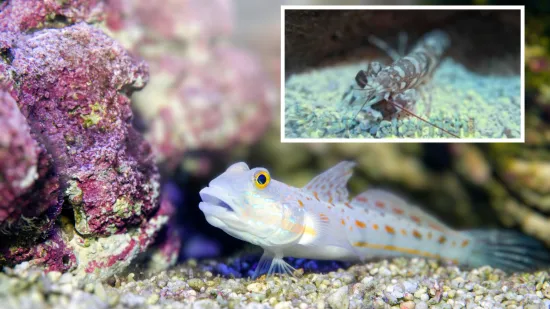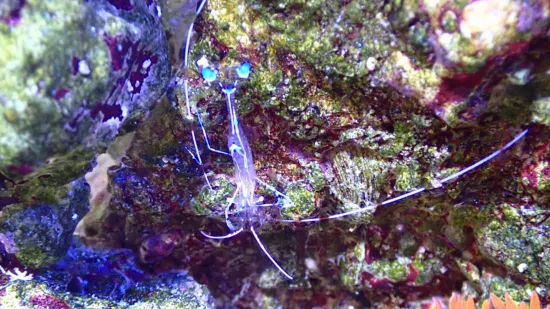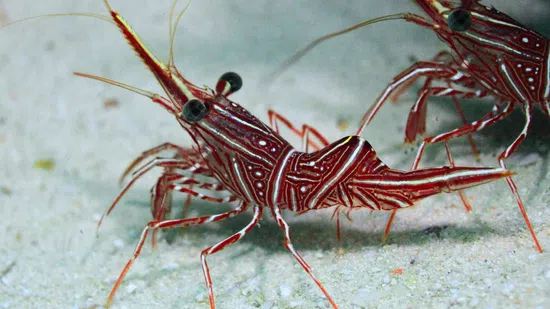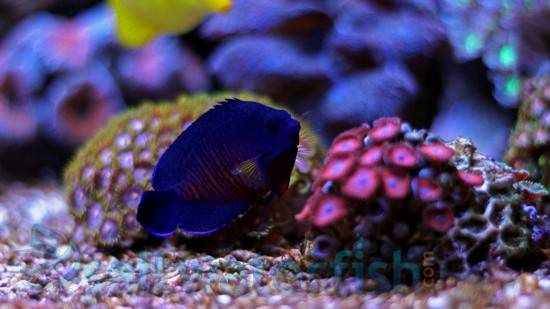Camelback Shrimp
Rhynchocinetas durbanensis
(42 Reviews)
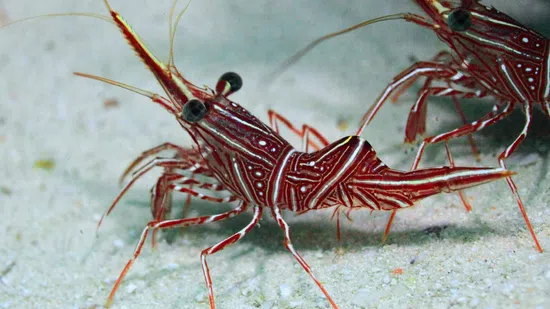
Camelback Shrimp
Rhynchocinetas durbanensis
(42 Reviews)
{{ item.name }}
Size: {{ item.extra_field_3 }}
${{ getFormattedPrice(item.saleprice) }} ${{ getFormattedPrice(item.price) }}
To join the waiting list, click here
Free Shipping
With
$199.00
or more in Marine Life.
More details...
Camelback Shrimp Care Facts
| Care Level: | Easy |
|---|---|
| Temperament: | Peaceful |
| Diet: | Omnivore |
| Reef Safe: | No |
| Minimum Tank Size: | 10 Gallons |
| Max Size: | 1.5 inch |
The Camelback Shrimp, Rhynchocinetas durbanensis, also known as the Camel Shrimp, Hinge Back Shrimp, Dancing Shrimp, Candy Shrimp or Humpback Shrimp, features a characteristic bump on its back with the same colors and patterns as the Peppermint Shrimp. It is a peaceful species that thrives in tanks with plenty of live rockwork and will be a beneficial tank member as it is a proficient sand-sifter, will feed on detritus, and generally keep the tank clean. Like most other Shrimp species, the Camelback Shrimp molts often releasing itself of its former exoskeleton as it grows larger.
The Camelback Shrimp (Rhynchocinetas durbanensis): A Delightful Addition to Saltwater Aquariums
The Camelback Shrimp (Rhynchocinetas durbanensis) is a captivating and unique species that adds a touch of quirky charm to saltwater aquariums. With its distinctive humpbacked appearance and peaceful nature, this shrimp has become a sought-after choice among marine enthusiasts. Let's explore the Camelback Shrimp's habitat, reef-safe nature, size, lifespan, diet, aquaculture potential, molts, other common names, and compatible tank mates.
Habitat and Distribution of the Camelback Shrimp
The Camelback Shrimp is native to the warm waters of the Indo-Pacific region, including the Red Sea and the western Indian Ocean. In the wild, they are often found in shallow reef areas with plenty of hiding spots among coral rubble and rocks.
Reef-Safe Nature of the Camelback Shrimp
The Camelback Shrimp is not considered reef-safe, making it an excellent addition to FOWLR aquariums. They are peaceful towards other invertebrates, and their presence can contribute to a thriving tank environment.
Size and Lifespan of the Camelback Shrimp
Camelback Shrimp are relatively small, typically reaching lengths of about 1.5 to 2 inches (3.8 to 5 cm). With proper care, they can have a lifespan of up to two years in a well-maintained aquarium.
Diet and Feeding Habits of the Camelback Shrimp
In their natural habitat, Camelback Shrimp are omnivores, feeding on various food sources, including plankton, algae, and small crustaceans. A home aquarium readily accepts a varied diet consisting of high-quality frozen and live foods such as brine shrimp, mysis shrimp, and marine pellets.
Aquaculture Potential of the Camelback Shrimp
The Camelback Shrimp is readily available in the aquarium trade, but most specimens are wild-caught rather than captive-bred. Breeding and rearing this species in captivity can be challenging, so they are predominantly sourced from the wild.
Molts of the Camelback Shrimp
Like other shrimp species, the Camelback Shrimp undergoes molting to grow and regenerate their exoskeleton. During this process, they may become more reclusive and vulnerable to predation until their new exoskeleton hardens.
Other Common Names for the Camelback Shrimp
In addition to the name "Camelback Shrimp," this species is also known as the "Humpback Shrimp,” Hinge Back Shrimp,” “Camel Shrimp,” or "Dancing Shrimp."
Five Compatible Tank Mates for the Camelback Shrimp
- Royal Gramma (Gramma loreto): Known for its vivid purple and yellow hues, the Royal Gramma is a peaceful fish that adds a splash of color to any aquarium. Its serene nature makes it a perfect companion for the Camelback Shrimp.
- Cleaner Shrimp (Lysmata amboinensis): These shrimp are recognized for their cleaning behavior, where they remove parasites from fish. Their peaceful disposition ensures they can coexist harmoniously with the Camelback Shrimp.
- Feather Duster Worm: This invertebrate is not only safe for shrimps but also introduces a unique visual element to the tank with its feathery tentacles that it uses for feeding.
- Six-Line Wrasse (Pseudocheilinus hexataenia): This vibrant and colorful fish is active and lively. While they can be a bit more assertive, in a well-structured tank with plenty of hiding spaces, they can coexist with the Camelback Shrimp.
- Nassarius Snail: These snails are excellent scavengers that help in keeping the substrate clean. They burrow in the sand and emerge when they sense food, adding an interesting dynamic to the tank alongside the Camelback Shrimp.
The Camelback Shrimp (Rhynchocinetas durbanensis) is a delightful and charming addition to saltwater aquariums. Its unique humpbacked appearance and peaceful nature make it popular among marine enthusiasts. Aquarists can enjoy the beauty and grace of these captivating shrimp in their aquatic havens by providing them with a suitable environment, compatible tank mates, and proper care.
Reviewed by: Fidel Silvas on Oct. 8, 2025
Reviewed by: Donald Hernden on Aug. 31, 2025
Great invert to get for the tank
Reviewed by: Devin Short on July 10, 2025
Reviewed by: William Osmundsen on May 25, 2025
Reviewed by: Paul Krumm on May 20, 2025
Good size and seem to be very healthy.
Reviewed by: Perry Badeaux on May 1, 2025
Reviewed by: Thomas Loonam on Feb. 17, 2025
Reviewed by: Mikko Lavalley on Feb. 6, 2025
Live and well
Reviewed by: Walter M Corrales on Feb. 3, 2025
Reviewed by: Jeff Graham on Feb. 2, 2025
Reviewed by: Gregory Midkiff on Feb. 2, 2025
Very nice
Reviewed by: Shaun Huddleston on Jan. 29, 2025
Reviewed by: Lisa Brothers on Jan. 6, 2025
Reviewed by: Justin Smith on Dec. 24, 2024
Reviewed by: Lawrence Peck on Dec. 23, 2024
Fine
Reviewed by: David Grass on Aug. 14, 2024
Super cute, something out of the ordinary
Reviewed by: Kimberly Brogan on June 26, 2024
Reviewed by: Jason Ebert on June 25, 2024
Reviewed by: Bryan Steele on May 26, 2024
Reviewed by: Bryan Steele on May 21, 2024
Reviewed by: Barbara Hunter on May 13, 2024
Great size beautiful shrimp , everything is always perfectly packed my new go to fish store I used to shop elsewhere but they are way high priced. Love the sales here!!!
Reviewed by: Malissa Cruickshanks on April 17, 2024
Reviewed by: Rudy Minor on April 2, 2024
Reviewed by: Sylvia Hall on April 1, 2024
Reviewed by: Debbie Konechney on March 15, 2024
I like the red and white color on the stripes
Reviewed by: Jim Hauck on March 11, 2024
Reviewed by: Lynn Adams on Feb. 4, 2024
Reviewed by: Leticia Camacho on Dec. 13, 2023
Arrived dead
Reviewed by: William Nesselrotte on Dec. 5, 2023
I love the colors, and they're a good size and healthy. I have 2, one died, but y'all gave me a refund. I was impressed with how they find each other
Reviewed by: Eric Wilson on Nov. 19, 2023
Reviewed by: Marty Costello on Nov. 15, 2023
Beautiful colors, nice size, it only comes out when lights are off, 1 was shorted and 1 doa. i'm hoping once i have 3,after reship, they will be more active and visible.
Reviewed by: Eric Wilson on Nov. 9, 2023
Reviewed by: Lynn Adams on Nov. 5, 2023
Reviewed by: Jonathan Redden on Sept. 24, 2023
Reviewed by: Pamela Gray on Aug. 4, 2023
Reviewed by: William Shelton on Aug. 2, 2023
Awesome
Reviewed by: Robert O'Brien on July 31, 2023
Reviewed by: William Shelton on July 28, 2023
Reviewed by: Ronica Lynn Terrell on July 19, 2023
Arrived in good shape, disappeared into the reef and hasn't been seen since.
Reviewed by: J. Hall on May 11, 2015
Reviewed by: Lisa Waldron on Oct. 1, 2014
Reviewed by: Oscar Tello on Sept. 20, 2014


